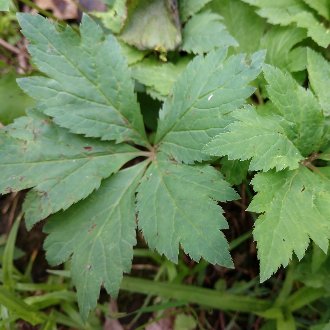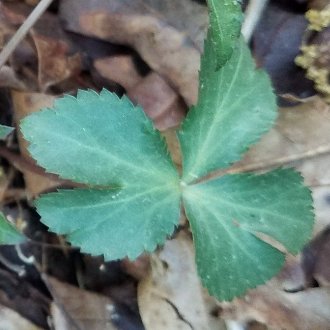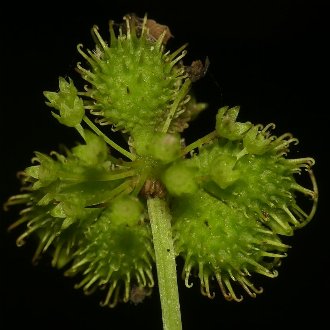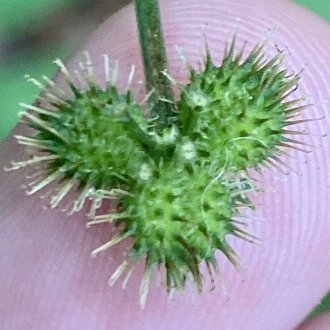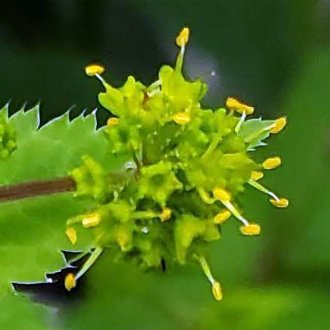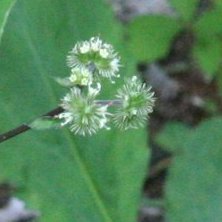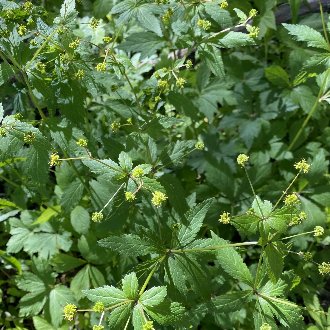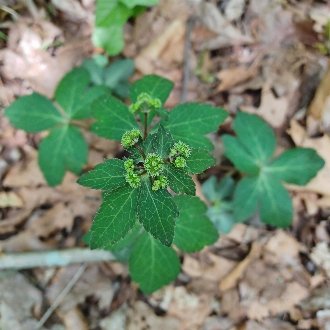Clustered Blacksnakeroot vs Small's Blacksnakeroot
These species are sometimes confused, owing in part to several widely-circulating misidentified specimens and photographs that have been reproduced on numerous websites. They are easy to distinguish by leaf shape, color, and texture, as well as by differences in inflorescence or fruit. There is also less overlap in habitat between these species than between most Sanicula; S. odorata prefers sunnier, moister, more disturbed habitats, and is restricted to open deciduous woodlands, whereas S. smallii prefers shadier, drier, less disturbed habitats with more intact leaf or needle litter, and can be found in both deciduous (especially oak) and mixed pine-hardwood forest.
Clustered Blacksnakeroot (Sanicula odorata) | Small's Blacksnakeroot (Sanicula smallii) |
A biennial of rich, deciduous woodlands, favoring sites that have experienced some recent disturbance. | The only perennial Sanicula in the eastern US, found in the southeast. |
Usually has 5 leaflets per leaf, or occasionally 3 leaflets with two of them deeply subdivided, giving a 5-leaflet-like appearance. Leaflet margins are jagged, with large, irregular teeth in addition to fine serrations. Photo © Nathan Rauh, Public Domain. | Usually has 3 leaflets per leaf and often leaflets are only slightly subdivided, so leaves look like they have three leaflets. Leaflet margins are finely serrated but otherwise more smooth and rounded. Photo © Leila Dasher, CC BY 4.0. |
Fruits are on short, but consistently visible pedicels. Long, recurved styles are often still attached as fruits mature. Photo © Shaun Pogacnik, Public Domain. | Fruits are sessile (attached directly, without a stem) or nearly so. Photo © Emily Summerbell, CC BY 4.0. |
Flowers petals are greenish yellow; anthers are conspicuous and bright yellow. Photo © aarongunnar, CC BY 4.0. | Flower petals range from bright white to greenish white. Anthers are less conspicuous and white. Photo © runcator, CC BY 4.0. |
"Gregarious": often found in large colonies, forming a mass of vegetation. Found in sunnier, moister, more disturbed habitats with recently-exposed soil. Usually only found in deciduous forests. Photo © Jim Bowhay, Public Domain. | Much more likely to be solitary or only in small groups, usually with more space between individual plants. Found in shadier, drier, less disturbed habitats with more leaf or needle litter. Found in deciduous or mixed pine-hardwood forest. Photo © Rene, CC BY 4.0. |
References & External Resources
These short lists show only links helpful for ID. For a complete list of references and resources also covering other aspects of ecology, visit the links section of the full article on each plant, which is the first entry here.



